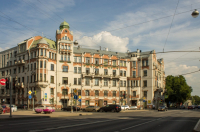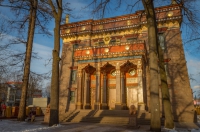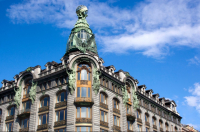When thinking of Russia's cultural capital, one probably will imagine Nevsky Prospect, the dazzling Winter Palace, and the magnificent St. Isaac’s Cathedral. But history is more than world-famous sights. It also lurks just around the corner, hiding in stained glass windows, ceramic-tile stoves, and abandoned 19-century cottages. Faded over time, or damaged by human invigilance, such gems are at risk of disappearing and never telling their story. And since the state can’t take care of every fretwork, it is the citizens who take the initiative into their own hands to change the city for the better, piece by piece.
Named in honor of the main character of a Mark Twain’s novel who is famous for his fence painting activity, this is a festival that unites volunteers and sponsors to restore the historical environment, with particular focus on the renovation of wooden houses. Established in 2015 in Samara by Andrey Kochetkov, nowadays it covers more than 30 cities and towns all over Russia. One of the features of the festival is that most restored objects don’t have the special conservation status of an architectural monument or historical heritage, which means that their restoration is unlikely to be initiated by the state.
Here, volunteers can get involved in tidying up old buildings, working with carved wood and acquire some related skills, as well as participate in sketching sessions and bookcrossing, or simply have a cup of tea with their colleagues. Among its key values, the project points out altruism and awareness of the social aspects of preserving the historical urban environment.
Gang (Гэнгъ)
Organized by bloggers Ksenia Sidorina, Maxim Kosmin, Maria Tychinina, and Alexey Shishkin, Gang refer to themselves as an informal community of heritage lovers. Since 2019, they’ve been washing architectural elements of St. Petersburg – stained glass windows, ovens, panels, and tiles.
The Gang runs various projects available for volunteers: the restoration of mosaic playgrounds, washing 19th-century tombstones at the Smolenskoye cemetery, tidying up tiled archways, and that’s not even a full list. Recently, the team moved forward and held their first event in Moscow.
For some people, these are just insignificant details easily lost in the interiors of сommon areas, but the love and affection of the community to what this team does definitely pays off. The local news portals keep a close eye on the project, proudly covering events and drawing even more attention to the community. What’s curious, according to one of the organizers, is that not all the events receive positive feedback from the local residents: some of them don’t trust anything free, while others are not welcoming towards strangers on their premises, even those with good intentions.
A related example of state initiatives is the Open City project, which provides a wide range of opportunities for its participants to explore the unique cultural heritage of St. Petersburg that is hard or impossible to reach for general tourists. The scope of activities includes city tours on bikes, buses, or hiking. One of those sections is dedicated to volunteering, too – at the last event, volunteers got the chance to visit the Finnish Manor of Sajets in Zelenogorsk and clean the area around it. Of course, with this project, the whole process is well-arranged: the organizers provide transfer, guided tours, and lunch breaks, which increases the number of people willing to contribute thus it’s not so easy to become a participant.
There are always plenty of ways to help! And regardless of whether the initiative is coming from organizations or from the state directly, it’s a great chance to preserve the history of the city for future generations and for yourself.
Curious to learn more about St. Petersburg and its hidden gems? Check out our Unexplored series!




